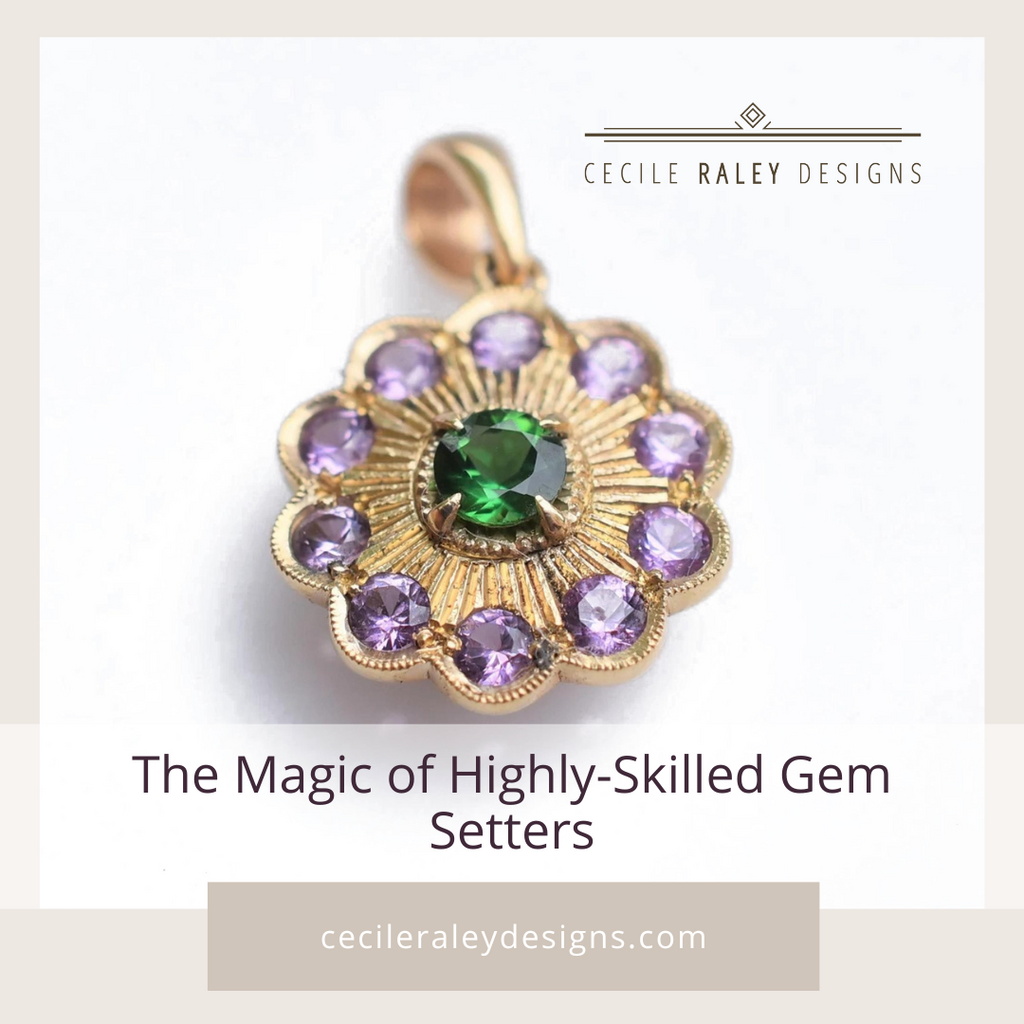The Magic of Highly-Skilled Gem Setters

‘Prong pusher’ is a rather derogatory term and not entirely fair, as 99% of jewelry sold on the mass market these days is prefabricated to simplify labor and save time and money that way. Simple prong setting is both fast and fairly easy. It also doesn’t require a lot of tools.
For this reason, mass produced jewelry is more affordable. And we all want to save money! Or do we?
Well, that depends on what kind of look you want in the end, as real hand setting also looks much more richly-detailed and special. In this blog, we want to show you how genuine “hand setting” works so you can understand and see why it looks different. And, yes, there it is: why it costs more. Good setters are in demand, they are always busy, and they earn good money. The best of them turn down work from anyone they don’t know or haven’t been introduced to by someone they know.
Before we get down to the nitty gritty details, let me get a misconception out of the way. All (or almost all) setting is done by hand in some shape or form. The only exception is when ‘casting gems in place’ where the gemstone is cast together with the jewelry piece. But this only works for diamonds and certain synthetic stones as natural gemstones will just get fried by the heat of casting. Also, it still involves some type of setting, in this instance, the setting is done in the wax.
In this blog I want to focus just on prong and pave setting, not bezel setting, rub over, snap setting, or any other type.
Simple Prong Setting
Prong setting literally involves only pushing the prongs over the stone. But nothing is basic. Generally, prongs must be clipped down and refiled, and with most settings, grooves have to be cut into the prongs where the gemstone will sit. That’s called “cutting the seat.” You will need a jeweler’s lens, a handheld drill, the right drill bits, bench and bench pin. Click here for an article on the tools that make up a jeweler’s work bench.
Pre-Set Pave Setting
In the pavé setting alternative, the prongs are actually little balls of metal, called “beads.” Beads are short and stubby. These beads are added in the CAD, together with guideholes that tell the setter where the gems will go. Sometimes these guideholes have to be opened up a little bit more by the setter. Millgrain can be added in the CAD also, as well as any kind of engraving. The setter places the gem into the seat and gently pushes the beads over the gem, or down from the top.



We did it this way because you cannot millgrain a half round shank, and we were setting cabochons which don’t have a girdle.
Hand Setting, Prong
For simple prong setting, the process is very much the same as above, except that the prongs are always cut and then filed into claws (unless the prongs are shared because no claw can point in two directions at once). The setter cuts the seat as well. But the added experience of the hand setter can still show that their work is a cut above, because the height of the gem in the setting will be just right, the prongs not crooked and the claws very small.


Hand Cut Pave
Now here’s where hand setting really makes a difference! For hand setting, you will not find either millgrain or beads in the model. You will get guideholes because in the CAD software you can easily place those perfectly evenly. This comes in handy when you are making an eternity band with alternating colors so you need an even and perhaps exact number of gems. When we do our eternity bands, we do not have guideholes. We start with a simple wedding band. The setter then scoops out the prongs, drills the holes, one at a time. He can even split the prongs down for what is called a ‘fishtail pave’.


For uneven gems like most colored stones, hand setting can be very helpful, as the setter can ‘even out’ a slightly wonky gem by how he drills the hole and places the bead. They can also put more beads in between stones if the stones are smaller than expected. They can add a pattern with beads. And for the millgrain, as well as for the overall more elegant facing up of “bright metal”, they will cut the metal around the stone at an angle, literally called the “bright cut”.



Aside from considerable expertise as well as time spent on hand pave setting – figure on about triple the time, if not more – you also need to own a microscope. A jeweler’s lens will not have enough magnification or enough light. These microscopes cost upward of $3000.
But really, words cannot capture it. You have to see it for yourself. Here is a video our setter, Pierre Berberoglu, produced which follows him through the entire magical process of setting gems by hand. This video was made with the aid of a special camera. Note that the video is condensed and sped up. The work actually took 45 minutes (and he is a very fast setter - another person might work on this for an afternoon). With a pre-set piece, this time can be slashed down to one third or less.
And voila! Here is the finished piece:

